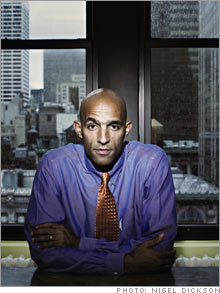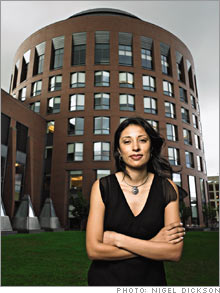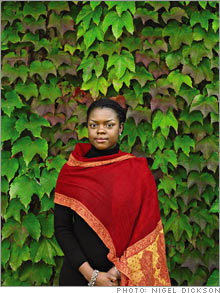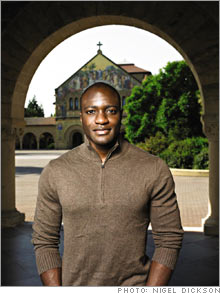The race to bring more diversity to businessMany of the best and brightest black and Hispanic college grads forgo business school for study in other fields. John Rice has an idea why - and he's starting to change the MBA game. Fortune's Nadira A. Hira reports.(Fortune Magazine) -- There's a hole in higher education that you probably haven't heard about. At American undergraduate schools, 23 percent of the students are black or Hispanic. At the top 20 colleges, they account for 14 percent of the student body. The top 20 law and medical schools? Fourteen to 15 percent.
But at the top 20 business schools, blacks and Hispanics represent just 7 percent of the student body. In the current second-year class, that's about 900 people. For companies struggling to diversify their ranks, those numbers make recruiting a little like chasing the only woman at a party of investment bankers. She can have anyone she wants, and just about everybody's going home alone. So what's a diversity officer to do? You can't hire people who aren't there. So you have to find a way to get superstar minorities to go to the top MBA programs, where you can one day woo them. And there's only one program that does that. Management Leadership for Tomorrow started out as an independent-study project at Harvard Business School. John Rice, a second-year student, wondered why there were so few nonwhite faces in the program. He found that many of the most talented minority graduates from elite colleges didn't even consider going to business school, mainly for cultural and sociological reasons. So he started a nonprofit organization to address those issues, introducing graduates to the business world through seminars, coaching and test prep. Today he has a monster hit on his hands. MLT is the No. 1 source of minorities for the top ten MBA programs. (MLT uses a composite ranking system that derives from the business school ratings published by U.S. News & World Report.) At HBS, 40 percent of the minorities entering in 2005 were MLT alums. The group has partnerships with HBS, the Wharton School, Stanford Graduate School of Business and a growing number of other top schools, and with a broad range of companies, including McKinsey, Goldman Sachs (Charts), McGraw-Hill, the National Basketball Association and Citigroup (Charts). Rice, it seems, has something they all need. "Talent is our most important asset," says Chuck Prince, CEO of longtime MLT partner Citigroup. "But unfortunately there's a very limited diversity pipeline in the U.S. at the present time, so when someone comes up with a unique, innovative and interesting new idea and brings the positive power that John does, it has the potential to have a dramatic impact in the next five, ten, 20 years." And it isn't just a matter of getting a few good black and brown folks into B-school. For Rice, the most important statistic is the one at the end of the pipeline: Only 3 percent of senior management at Fortune 100 companies is black or Hispanic. He doesn't think that's a coincidence or a conspiracy: He thinks it's a social question - many nonwhite kids lack early exposure to the corporate world, and they often find a career at Goldman Sachs a far less realistic - and perhaps less worthwhile - goal than making partner at Skadden Arps or saving lives at St. Vincent's Hospital. Talented minorities don't pass business by because they aren't interested or won't succeed; they simply don't see it. Opening doors It's a muggy June day in Midtown Manhattan (for many brown women, that normally means a bad hair day), but you couldn't tell it by this MTV Networks conference room. In it, a few dozen MLT students of both genders sit straight, all in dark suits, hair perfectly coifed, expressions rapt. Five of their compatriots are performing a role-playing exercise: They're giving MTV Networks executives an old-fashioned butcher-paper presentation about how the network might update its advertising strategy. One idea - creating episodic, commercial-length shows to keep kids hooked during the breaks - draws approving nods from the judges. The exercise is part of a four-day 'boot camp" that caps the 18-month program at MLT. Though these students are hardly your typical "hood-to-Harvard stories" they all have top-notch résumés - many are the first in their families to graduate from college, let alone apply to graduate school. They don't have an Uncle Henry at Booz Allen or an Aunt Jane on Wharton's board to help them. "Both my parents are educators, and I still didn't understand what business was all about," says Ime Archibong, who began his MBA studies at Stanford not long after attending the MTVN seminar. "MLT provides us that access. It's not every student that gets to sit with a recruiter and ask, 'What are you looking for?' " And often the students don't know what they're looking for either. Sean Heywood's story is pretty typical: The MLT alum says it was in the cafeteria at Brown University that he first heard about investment banking, a career he then researched and pursued. But once these students settle on business as a potential field, a quick survey of their situation can leave them panicked. They don't know the jargon, they don't have a network, and because they didn't know they wanted to go to business school in the first place, they're late to the résumé-packing and essay-writing frenzy that is the application process. And many like Heywood - who recently received an MBA from Stanford - have what they consider nontraditional résumés. For him, jobs at Morgan Stanley and Merrill Lynch during tough economic times had resulted in layoffs and a soul-crushing focus on what he calls his "developmental needs." Heywood says it wasn't until Rice dropped in on one of his writing sessions with an MLT staffer that he got his confidence back. "He sat and listened, and somewhere in the middle he said, 'Sean, you went to Hotchkiss, Brown, graduated magna cum laude, you have a great GPA, great GMAT score, you worked at Morgan Stanley, McKinsey. This is your ball to drop,' " Heywood recalls. "Nothing anywhere else had ever been so confidence-engendering." Obstacles to advancement But getting some swagger into your step is only the start, because compared with a legal or medical degree, an MBA's value can be difficult to calculate. This is especially true in black and Hispanic communities, where students tend to be focused not just on the potential for advancement and wealth but also on their ability to give something back through their professions. "If you're a doctor or lawyer, you can work in the communities you care about, being an affordable pediatrician or a lawyer defending youth of color in the legal system," says Michelle Wonsley, an MLT alum who's at Cornell's Johnson School. "But business is not as clear-cut." And to an extent that very few whites understand, they worry that to succeed in business they will have to leave race and culture behind. Carmen Bonilla, who's at NYU's Stern School of Business, laughs when she remembers a conference for the National Society of Hispanic MBAs: "We had a big party with Latin music blasting, and we were all dancing. And this guy says to me, 'I can't believe all these successful Latinos are here.' Like we couldn't succeed in corporate America and still dance salsa." Even with all that addressed, Rice says, there is another problem: A degree in law or medicine leads to a license to practice, a fair guarantee that you will always be able to do something. An MBA doesn't. That can be hard to swallow, especially for families. When Heywood broke the news to his parents that he no longer wanted to be a doctor, they dropped him off at his dorm at Brown and drove straight back to their Brooklyn home without saying goodbye. "They were that upset," he says. Even when a young person lands a corporate job, giving it up to pursue an MBA can seem like a betrayal. Parents, Rice says, often think, "You went to college to get a great job. Now you have a great job, and you want to leave it to go back to school, go into more debt, and come out looking for another great job. It just doesn't make sense." And that's where MLT steps in, becoming Mom, Dad, Uncle Henry, Aunt Jane and everyone else one might need in a support system. "John embodies something these kids can aspire to," says Holly Jackson, MLT's director of alumni professional development. "And it's not 20 years off. He's intense and very tactical, but he's still a big kid - goofy in a suit, and the first on the dance floor. They want to be like him, and they want to be liked by him." A head for business Riding down Greenwich Street in New York City's West Village in a rented SUV, John Rice is agitated. He clutches the handle above the window, shaking his head in exasperation. "Why did we get off the highway?" he mutters, before raising his voice for the driver to hear. "See that red umbrella right there?" he says, pointing to the towering Citigroup building. "That's where we're going, and I really think we need to get back on the highway." By the time the SUV delivers him to the building, Rice is 15 minutes late. "Listen," he says, leaning his 6-foot-3 frame forward to address the driver, "we're going to be here for about an hour, and while we're in there, I want you to plot out a course in your head to get us from here to [my office] as quickly as possible. Can you do that for me before we get back?" It would be a cringe-worthy moment for most people, but Rice isn't really being a jerk. He's just getting the job done. And he's the same with the students in MLT. They aren't coddled when they're late to events or miss deadlines; they're asked to leave, because as Rice sees it, MLT has important work to do and no time to waste. Rice, 40, is the son of two highly educated professionals. His father was an economist at the World Bank and a governor of the Federal Reserve System, and his mother, the youngest child of a poor Jamaican family in Maine, won a scholarship to Radcliffe College and made a career in education. Rice had no dearth of opportunity. He attended an elite prep school in Washington, D.C., then went on to Yale, where he majored in Latin American studies and played basketball. After two years in marketing and sales at AT&T, he headed to HBS, where he did his independent study on the lack of brown faces. He graduated in 1992, wrote a business plan, got a few companies to give him $10,000 each and began a one-on-one mentoring program. In 1994, while he was working in new-business development for Walt Disney, he formalized his mentoring program into a nonprofit and called it MLT. He moved on to the NBA, where he rose to managing director of NBA Japan. Then, in 2000, he reached a turning point. "My father wanted to change the world, and he thought he could do that through monetary policy," Rice says, "but he realized you have to have economic power to really shape the world, and that always stuck with me." He quit his job, asked Boston Consulting Group - already an MLT partner - to do some research for him, and embarked on what he's dubbed "Minority Empowerment 2.0." That 2001 BCG study became the basis for the enrollment figures we've quoted, one of few comprehensive studies of its kind. (Many business schools don't disclose their minority enrollment numbers, partly because they are sensitive about revealing such things as who actually counts as a minority.) Armed with the stats and some recommendations from BCG on maximizing MLT's effectiveness, Rice quickly secured a $2 million grant from the Atlantic Philanthropies. In 2002, Rice launched MBA Prep, a program for business school applicants that includes intensive GMAT preparation and mentoring on everything from essay writing to etiquette. MBA Prep's centerpiece is a series of four weekend seminars hosted by MLT's business school partners, featuring admissions officers and corporate recruiters. And before the students leave for business school, MLT puts them through its June boot camp. There they can watch mock consulting interviews with BCG executives, devise advertising strategies for MTVN staffers, and hear from Citigroup employees about what a day in the life of an investment banker is like. Throughout, the students build confidence. For Archibong, that started at his first MLT seminar, when he endured an hour of public interrogation by Rice - about his passions, goals and other issues he hadn't considered much. At the start, his MBA Prep peers were asked if they thought Archibong could achieve his dream of becoming a CEO. Few did. "I think the five people who'd talked to me at lunch put up their hands," he jokes. But when the same question was asked at the end, all hands went up. Another MBA Prep student, Pamela Velarde, who grew up in Peru, says, "Where I came from, just thinking about an Ivy League school was like, wow. But then I got to MLT and met all these Ivy League students, and I realized, I can do this - they're just normal people." She's now at Wharton. Test prep Since starting with 50 participants in 2002, MBA Prep has sent over 375 candidates to business school; it has 200 more in the current group. Participants' GMAT scores go up by an average of 100 points, with 80 percent scoring above 600 (out of 800), putting them in range for top 20 schools and vastly surpassing the national population of GMAT test takers, where even among whites and Asians only 33 percent score above 600. Over 85 percent of MBA Prep's last two classes went to a top ten B-school. MLT now has 30 staffers and an annual operating budget of $3 million. (MBA Prep participants pay their own travel costs, but everything else is covered by MLT.) Rice hopes to raise that to $10 million in the next three years; the program recently received nearly $2 million in cash and consulting services from Boston-based philanthropy fund New Profit Inc. MLT's partners include nonprofits, 27 business schools that rank in the top 35 and 30 core corporate partners, each of which contributes $25,000 to $1 million and in-kind support. It all makes for an organization COO Fred Smagorinsky calls a "nonprofit that feels like a startup." Says alum Wonsley: "If you look at nonprofits, there are usually a lot of people who have their hearts in the right place. But MLT people & have their minds wrapped around what they're doing, and they're doing it with a textbook approach to supply and demand." Still, Rice sometimes seems more preacher than president. "He would probably say he's more of a demotivational speaker than a motivational one, because he's so demanding," Smagorinsky, a former Sealed Air corporate vice president, says, laughing, "but everyone really responds to him." Rice is the kind of speaker who stares off into the distance, searching for just the right word. He can take five minutes to finish a sentence. But there is no doubting his rigor. As one recruiter put it to Wonsley, "I know you're in MLT, so if your application isn't perfect, I'm going to think something's wrong with you." So what about Rice's bottom-line question? Will more blacks and Hispanics get better corporate jobs because of all this? Perhaps. In the past two years Citigroup made over 50 offers for internships and full-time positions to MLT participants, making it the company's most diverse intern class ever. And at Goldman, MLT alums held 15 full-time posts and 15 summer internships this year. Even new partner General Mills (Charts) made more than ten MLT full-time and internship hires in the past year. It remains to be seen how high they'll go, but for now Rice is just glad they're in the right elevator. That day at Citigroup, with the hapless SUV driver waiting at the curb, Rice introduced me to 32 MLT students at a boot camp seminar. I asked the group how many of them would have been going to business school had it not been for MLT. About half slowly raised their hands. Then Silvia Medina piped up, "I definitely could have gotten into business school, but would I have gotten into the three that I applied to? Never." Her question was better than mine, so I put it to the group: Had MLT enabled them to get into an elite business school? This time every hand shot up. As Heywood puts it, "When you go from not knowing if you could get into business school to getting into the four top schools you applied to, you're not just an ambassador - it's hard not to be an evangelist for MLT." He pauses, then says, "John is selling hope." And not just to the students. ___________________________ From the November 27, 2006 issue
|
|




